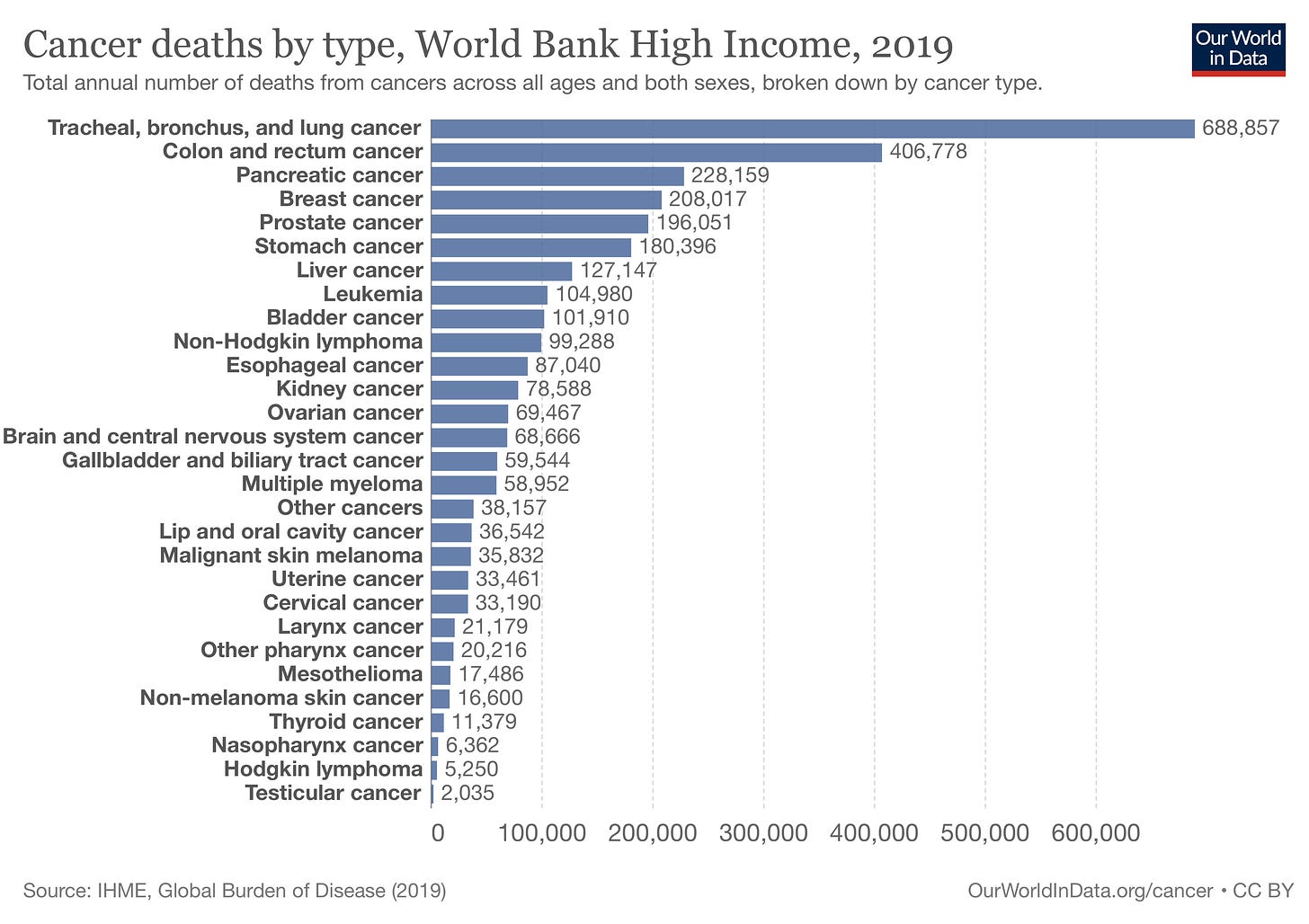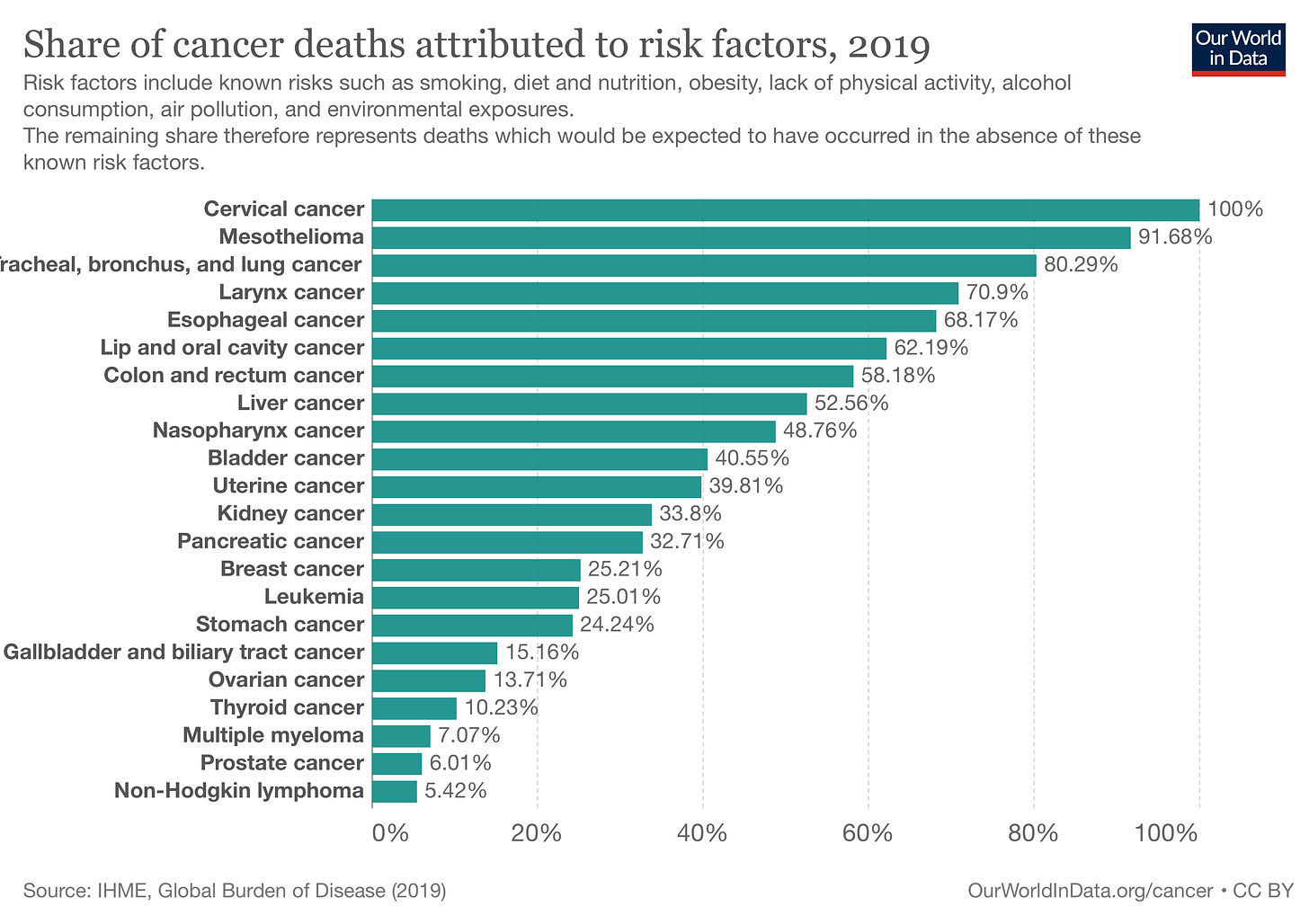Cancer Prevention Strategies

Cancer is the second leading cause of death in most developed nations1.

And just like cardiovascular disease, it is largely preventable.
There is a substantial overlap in the risk factors for both conditions.
This is why decreasing your risk of cardiovascular disease decreases your risk of cancer.
But let’s be VERY clear about what we mean by prevention.
There is no 100% way of preventing all possible cases of cardiovascular disease, just like there is no 100% way of preventing all common cancers.
Some people do EVERYTHING right when it comes to heart disease prevention and still get heart disease.
This is possible. But just very unlikely.
Always remember, this is a game of odds. There are no guarantees.
The same is true of cancer.
There are those who have never smoked but still get lung cancer.
But of those who get lung cancer, 80 to 90% were smokers2.
It is all about the odds.
Secondly, this is ABSOLUTELY NOT about blaming people with cancer for not doing the right things in the past. This is about giving people information early in life to decrease their odds of developing cancer in the future.
Unlike coronary artery disease, there is a multitude of different cancers. As we are in the game of tilting odds, we will largely focus on decreasing the risk of the leading causes of cancer deaths.
In high-income countries, the leading causes of cancer deaths are:
-
Lung Cancer
-
Colorectal Cancer
-
Pancreatic Cancer
-
Breast Cancer Cancer
-
Prostate Cancer
-
Stomach Cancer
-
Liver Cancer

The majority (65%) of cancer deaths occur in those over 70 years of age.
However, 30% of cancer deaths occur between the ages of 50 to 69 years of age3. People in this category are losing 20 to 30 years or more of life expectancy, which is a huge amount in terms of an average lifespan.
Cancer is predominantly a disease of older people, but for more than 1 in 3, it’s not.
Factors That Prevent Cancer
Smoking
In terms of odds, not smoking is going to have the biggest bang for buck.
As lung cancer is by far the leading cause of cancer deaths, being a never-smoker is going to make the biggest impact on decreasing the chances of dying from lung cancer. But the benefits extend far beyond lung cancer prevention.
Compared to never-smokers, current smokers have a significantly increased risk of many other cancers4:
-
Head & Neck Cancer - 2.5 Times Increased Risk
-
Oesophageal - 3.8 Times Increased Risk
-
Liver Cancer - 4 Times Increased Risk
-
Bladder Cancer - 3 Times Increased Risk
-
Pancreatic Cancer - 2.7 Times Increased Risk
-
Colorectal - 1.3 Times Increased Risk
While most people will be very familiar with the concept of not smoking to prevent cancer, there are many other factors that contribute to increased cancer risk.
HPV Vaccination
The HPV (Human Papilloma Virus) vaccine could prevent 90% of all cancers related to it. The most common cancer related to HPV is cervical cancer, but there are others, including oropharyngeal, anal and genital cancers5.
Although these are not leading causes of cancer deaths by numbers, the magnitude of reduction for these specific cancers with HPV vaccination is significant.
Additional Factors
The following graph demonstrates the percentage of cancer deaths attributed to risk factors. For cervical cancer, that figure is effectively 100% because of the HPV impact discussed above6.
The next 5 cancers are largely a function of smoking exposure. And while smoking does influence many of the remaining cancers, there are other factors that also increase their risk.

Physical Activity
Comparing those who exercise regularly to those who do not demonstrate significant differences in the risk of many cancers.
All Cancers - 11% Less Risk
Lung Cancer - 25% Less Risk
Colorectal Cancer - 26% Less Risk
It is estimated that 1 in 10 cancer deaths are attributable to insufficient physical activity7.
Additionally, regular physical activity has also been shown to decrease the chances of cancer recurrence8.
Obesity
After smoking, obesity is the second leading cause of preventable cancers9.
Combined, smoking and obesity account for 50% of all preventable cancers10.
I suggest you read that last line again and let it sink in, given the fact that in high-income countries, 1 in 5 people still smoke, and 57% of people are overweight or obese1112.
Being in the obese category increases the likelihood of being diagnosed with colorectal cancer by up to almost a factor of 4 over a 10-year period13.
While obesity reflects an increase in total body weight, there is evidence to suggest that it is visceral fat (The fat in your abdominal cavity) that is a major driver of risk. And in those with high visceral fat, the likelihood of colorectal cancer recurrence is significantly higher14.
Metabolic Syndrome
Over 40% of adults over 50 years of age have metabolic syndrome which is characterised by having 3 of any of the following 5 features: Increased waist circumference, high blood pressure, high triglycerides, low HDL cholesterol & abnormal blood sugar control15.
Having metabolic syndrome significantly increases your risk of several leading cancers16:
-
Postmenopausal Breast Cancer - 52% Increased Risk
-
Hepatocellular Cancer - 81% Increased Risk
-
Colorectal Cancer - 30-40% Increased Risk
-
Pancreatic Cancer - 55% Increased Risk
The list of factors associated with an increased likelihood of a cancer diagnosis extends to:
-
Alcohol: Moderate to heavy alcohol consumption is associated with increased rates of head & neck, oesophageal, liver, breast and colorectal cancer17.
-
Diet: Higher diet quality is associated with lower rates of many cancers, including colorectal and pancreatic cancer1819.
-
Sunscreen: Sunscreen has been shown to reduce the risk of several skin cancers20.
The number one way of not dying from cancer is not getting cancer.
Although our screening, diagnostic and therapeutic approaches to cancer have evolved significantly, the optimal outcome is to reduce your chances of getting it in the first place.
As you can see, there is a multitude of ways of reducing your risk of cancer.
Achieving these metrics of health may not be easy, but they are immensely valuable.
https://ourworldindata.org/causes-of-death
https://www.cancer.org/research/acs-research-highlights/lung-cancer-research-highlights/most-people-with-lung-cancer-smoked.html
https://ourworldindata.org/cancer
Cancer incidence and cancer death in relation to tobacco smoking in a population-based Australian cohort study. Int J Cancer. 2021 Sep 1;149(5):1076-1088.
https://www.cdc.gov/hpv/hcp/protecting-patients.html
https://ourworldindata.org/cancer
Combined impact of lifestyle factors on mortality: prospective cohort study in US women. BMJ. 2008;337:a1440.
Physical Activity Reduces the Risk of Recurrence and Mortality in Cancer Patients. Exerc Sport Sci Rev. 2020 Apr;48(2):67-73.
Cancer is a Preventable Disease that Requires Major Lifestyle Changes . Pharmaceutical Research, Vol. 25, No. 9, September 2008
Cancer is a Preventable Disease that Requires Major Lifestyle Changes . Pharmaceutical Research, Vol. 25, No. 9, September 2008
https://ourworldindata.org/smoking
https://ourworldindata.org/obesity
Assessment of Body Mass Index, Polygenic Risk Score, and Development of Colorectal Cancer. JAMA Netw Open. 2022 Dec 1;5(12):e2248447.
Body Composition, Inflammation, and 5-Year Outcomes in Colon Cancer. JAMA Netw Open. 2021;4(8):e2115274. doi:10.1001/jamanetworkopen.2021.15274
An examination of the prevalence of metabolic syndrome in older adults in Ireland: Findings from The Irish Longitudinal Study on Ageing (TILDA). PLoS ONE 17(9): e0273948.
Mendonça FM, et al, Metabolic syndrome and risk of cancer: Which link? Metabolism (2014),
https://www.cancer.gov/about-cancer/causes-prevention/risk/alcohol/alcohol-fact-sheet
Adherence to 5 Diet Quality Indices and Pancreatic Cancer Risk in a Large US Prospective Cohort, American Journal of Epidemiology, Volume 191, Issue 9, September 2022, Pages 1584–1600,
Diet quality indices and gastrointestinal cancer risk: results from the Lifelines study. Eur J Nutr. 2022 Feb;61(1):317-327.
The efficacy and safety of sunscreen use for the prevention of skin cancer. CMAJ. 2020 Dec 14;192(50):E1802-E1808.




